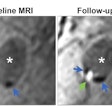VIENNA - Using conventional T1-weighted dynamic MRI to evaluate edema in breast cancer patients, radiologists and physicians can accurately assess pathology response after neoadjuvant chemotherapy, according to a study presented Sunday at the European Congress of Radiology (ECR).
"There is a good correlation between the reduction and resolution of the edema on MRI during neoadjuvant chemotherapy and a pathological response to the treatment," said lead study author Dr. Marianna Telesca, from the University of Rome "La Sapienza" in Italy. "In a patient treated with neoadjuvant chemotherapy, reduction and resolution of the edema on MRI could be an additional important factor for treating response."
Neoadjuvant chemotherapy has become the standard treatment for locally advanced breast cancer. The advantages are an improvement in survival and a reduction in the size of the primary tumor, which could result in more conservative surgery. MRI, in the meantime, is the most effective modality to assess the extent of residual tumor response.
Predicting response
"Reduction in the size of the primary tumor on MRI helps predict clinical and pathologic response after neoadjuvant chemotherapy," Telesca said. "But what about other findings associated with the primary tumor, for example, the edema?"
The retrospective study enrolled 146 patients with advanced breast cancer between January 2005 and January 2010. Of those patients, 120 women had invasive ductal cancer, 18 subjects had invasive lobular cancer, and eight had mixed ductal and lobular cancer.
Dynamic MRI was performed in all patients before and during neoadjuvant chemotherapy. All 146 patients were imaged on a 1.5-tesla MRI system with a dedicated breast coil.
The breast MRI protocol included precontrast T2-weighted short-tau inversion-recovery (STIR) sequence and a dynamic 3D T1-weighted FLASH sequence acquired before and at two-minute intervals after administration of gadobenate dimeglumine (MultiHance, Bracco Diagnostics) at 0.1 mmol/kg body weight.
Edema reduction
Patients were also divided into two groups according to edema changes observed during neoadjuvant chemotherapy. Patients with edema that appeared reduced or absent were placed into one group, while patients with no apparent variation in edema were set in the second group. Responders were defined as patients whose edemas decreased by more than 90%.
Two radiologists reviewed the MR images independently and compared findings from pathologic assessment of surgical samples obtained after neoadjuvant chemotherapy. Results were confirmed with the final histological analysis, and the pathological response to the treatment was assessed.
The analysis found that 114 patients (78%) were responders of neoadjuvant chemotherapy. In these patients, edema was reduced or absent in 79 cases (69%). The remaining 32 patients (22%) did not respond to neoadjuvant chemotherapy. In eight patients (25%), the edema was reduced or absent.
'Good correlation'
Telesca and colleagues concluded there was a "good correlation" between the reduction or resolution of edema on MRI during neoadjuvant chemotherapy and a pathological response to the treatment.
"In a patient treated with neoadjuvant chemotherapy, reduction and resolution of the edema on MRI could be an additional important factor for treating response," she said. "So, STIR sequence should be used in addition to T1-weighted dynamic contrast MR imaging in this group of patients."



.fFmgij6Hin.png?auto=compress%2Cformat&fit=crop&h=100&q=70&w=100)




.fFmgij6Hin.png?auto=compress%2Cformat&fit=crop&h=167&q=70&w=250)











